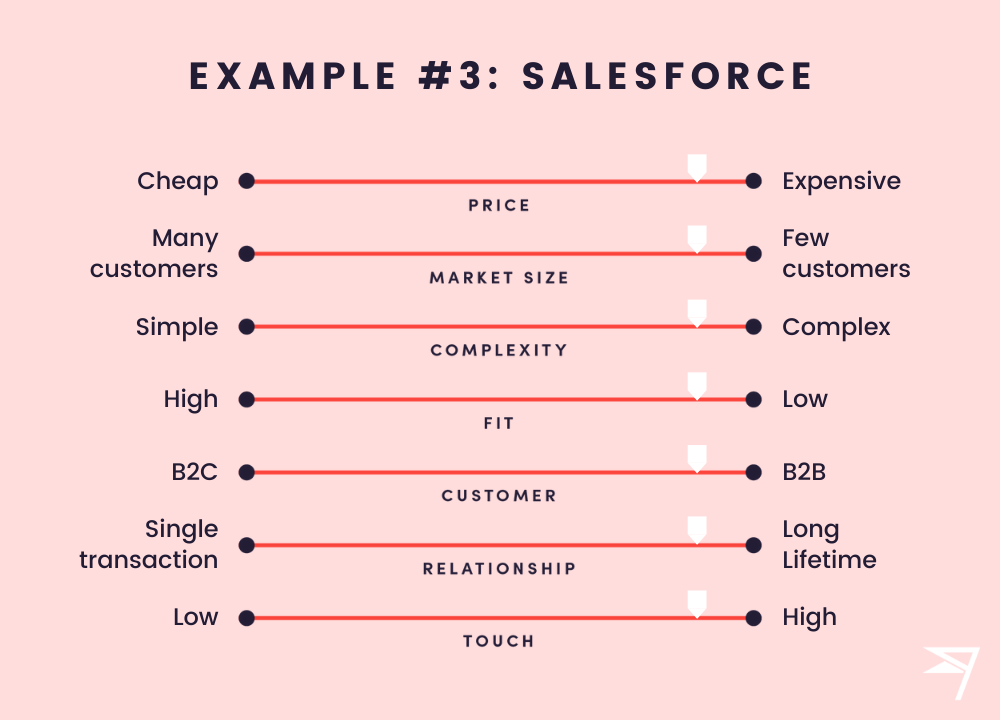Should my go-to-market strategy be marketing or sales led?
It’s a question software founders often find themselves asking — do I pour my time and budget into marketing spend, or prioritise this towards sales initiatives?
One of the best ways to determine whether your business is sales or marketing-led is to utilise Leslie’s Compass — a simple test that can help you determine exactly that.
Developed by Mark Leslie, a veteran software entrepreneur, investor and educator, Leslie’s Compass is a great tool to help you plot out your go-to-market strategy. It’s based on the idea that your business is either marketing or sales-led. The more you need of one, the less you need of the other. It’s an extremely helpful way to determine the right balance of each that you need to sell your product effectively.
So, what exactly does Leslie’s Compass entail?
The framework consists of a list of 7 attributes that will vary for different products. These are as follows:
Leslie’s Compass. Credit: Mark Leslie.
Price. Is your product cheap or expensive? This, of course, is a relative question so you need to consider this in the context of your industry and your customer. As the Leslie’s Compass overview asks: “Is this a large or small economic decision for (your) customer?”
Market size. Have you created a product for a small niche target market, or does it have mass appeal?
Complexity. How easy or complex is your product? Is your product simple and intuitive to use, or is a level of education and training required?
Fit. Is your product high or a low fit? A good clue here is the nature of your onboarding process. Is it easy for users to ‘plug and play’, or do they need a lot of help to get started? Does the product need to be customised to them first?
Customer. Am I selling to people or businesses? You could also think of this as selling the masses vs a niche business audience with specific needs.
Relationship. Is my product sold in a single transaction or will I be interacting with my customers over time?
Touch. Is your selling process transactional, or is a higher touch approach required?
The next step is to apply these attributes to your own product to determine where you sit.
If you’ve ticked most of the attributes over on the right, a sales-led go-to-market strategy is your best bet.
However if your ticks are sitting mostly to the left, a marketing lead approach is more likely to deliver results.
Example #1: Allbirds
Allbirds is a footwear company that manufactures shoes made from eco-friendly material such as eucalyptus tree fibre and sustainable foam derived from sugar cane. They sell directly to customers via their website and own physical retail stores. Founded in New Zealand, they have gone on to become a global success story.
So where does Allbirds sit on Leslie’s Compass?
Allbirds’ shoes have wide appeal to a variety of people. While price-point is always relative, it is a ‘cheap’ product compared to say, a piece of machinery or enterprise software. It’s a product that works straight out of the box and is bought by customers, not businesses. While a customer may return to buy again from Allbirds, there is only one transaction associated with the purchase of a single pair of their shoes.
With all of this in mind, Allbirds is a marketing-led business. It makes sense for them to market to many at scale, especially as they do not sell through wholesale channels.
Example #2: Canva
Canva probably needs little introduction here. As a global online design platform, it’s given anyone with a laptop and an internet connection the tools they need to create posters, invitations, social media graphics and more (regardless of design ability).
Let’s take a look at where Canva sits on Leslie’s Compass:
Canva is an interesting example of a marketing-led software business. A lot of its features and functionality are available free, and upgraded plans are accessible in terms of price-point. It provides a service that can be used by many — from businesses looking to DIY their own marketing collateral to individuals designing their own wedding invitations or Instagram posts. Given the mass market appeal, it makes sense to advertise to many, rather than sell to a few.
But some attributes sit on the right hand side. The product isn’t exactly tricky to use, but involves more thought and learning than say, putting on a pair of Allbirds straight out of the box. Payment is by ongoing subscription, rather than a single transaction. In terms of customer type, Canva is useful to individuals (B2C) AND businesses (B2B).
So as we can see from Leslie’s Compass, Canva is more marketing led than sales led, but they are likely to incorporate aspects of both into their go-to-market strategy.
Example #3: Salesforce
Salesforce is comprehensive customer relationship management (CRM) software. It is a feature heavy product used by some of the biggest brands in the world.
Where does Salesforce sit on Leslie’s Compass?
Salesforce sits squarely on the right hand side of the compass with a go-to-market strategy that is sales-led. It is a complex, high touch B2B product that is tailored to a business’ specific needs, and requires a significant cost investment over time.
For this reason, it would make sense for Salesforce to prioritise budgets for a high touch sales team over marketing. Any marketing spend would likely be geared towards supporting the sales team at each stage of the funnel.
Got a great product but not sure where you fit on the sales vs. marketing scale? We’ll help you work out your best go-to-market approach.





